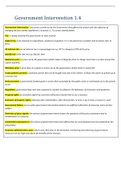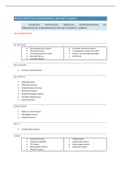Government intervention - any action carried out by the Government that affects the market with the objective of
changing the free market equilibrium / outcome i.e. To correct market failure
Tax- a charge levied by the government to raise revenue
Indirect tax- a tax imposed on expenditure, producers (suppliers). It is a tax placed on a product and increases costs to
firms
Ad valorem tax- an ad valorem tax is a percentage tax e.g. VAT is charged at 20% of the price
Specific tax- a flat rate tax e.g. 50p per item
Maximum price – a price set by the government which makes it illegal for firms to charge more than a certain amount for
a given quantity
Minimum price- a price floor on a good or service set by the government, below which it cannot fall
Trade pollution permits- a pollution permit that can be bought and sold in the market. It allows the owner to pollute up to
a certain limit
State provision- a government funded good or service that is provided by the public sector or contracted out to the private
sector
Regulation- government laws and rules imposed on markets to influence the behaviour of consumers and producers
Property rights- an economic agent has exclusive authority to decide how to use a resource
Extension of property rights- allowing other stakeholders, often third parties, to have a say in how a resource is used
Government failure- occurs when government intervention leads to an inefficient allocation of resources and a net loss
welfare
Distortion of price signals- the actions of government which distort the operation of the price mechanism and so
misallocation or resources
Unintended consequences- the actions of government that have effects that are unanticipated and not predicted by the
policymaker
Excessive administration costs- where costs that arise in the formation, monitoring and enforcing of governments
measures are too high and above the benefits of the measure.
Government information gaps- where the government has insufficient information to make rational economic decisions
,Governments tax goods with negative externalities:
The aim of this taxation is to internalise the externality that the good produces i.e. make the producer and or consumer of
the products cover the cost of its externalities.
§ It internalises the externality- the market now produces at the social equilibrium position and social welfare is
maximised.
§ It raises government revenue, which could be used to solve the externality in other ways such as through education.
This may help goods to become more elastic in the long run. The effect will depend on what the government does with
the revenue they raise.
Indirect tax- an expenditure tax that increases a firm’s cost of production but can be transferred
Why do governments levy taxes?
§ To raise revenue to fund essential public expenditure and transfer payments.
§ To redistribute income. They may impose or increase progressive taxation to reduce income of some groups in
society and use those to increase income of other groups
§ To correct market failures- taxation can be used to achieve the allocatively efficient outcomes in failing markets
§ To manage the macro economy- may change tax rates to influence variables such as growth, inflation, u/e and
the CA
,Indirect Taxation:
Indirect taxes will increase costs of productions for producers so they cause the supply curve to shift to the left (parallel
shift)
1. A specific tax increases costs of
production for suppliers (units
costs increase)
2. As a result supply shifts left (S to
S+tax) A
3. Therefore the market price
increases from P1 to P2
4. There is a contraction along the
demand curve resulting in a fall
in quantity from Q1 to Q2
Value of the tax is shown by vertical
distance between 2 supply curves
Disadvantages: there may be unintended consequences
§ It is difficult to know the size of the externality and so it is difficult to target the tax; the effect depends on where the
tax is set. The government suffers from imperfect information when setting the tax. As a consequence the tax might
be too low where the externality isn’t internalised
§ If tax is set too high- unintended conseq- gov failure- costs of intervention outweigh the benefits:
§ There could be conflict between the government goal of raising revenue and solving the externality, which makes
setting the tax difficult.
§ It could lead to the creation of a black market, highly dangerous potentially worsening the extent of externalities.
Created a new market failure
§ Consumers may go across the border and smuggle goods where taxes are lower/ non-existent- will not reduce
consumption won’t generate further tax revenue
§ If demand for the good is inelastic, then the tax will be ineffective at reducing output.
§ Taxes are politically unpopular and so governments may be reluctant to introduce them.
§ They are regressive, meaning they the poor spend a larger proportion of their income on indirect taxes than the rich
do.
Taxation evaluation points:
§ SPLAT
§ How much do you charge? (magnitude linked to effectiveness)
§ For how long do you charge it, short run v long run?
§ Raises the costs of production…may decrease supply = JOBS
§ May lead to informal economy (black market/crime)
§ Is a tax (Increase in price) ‘fair’ for lower income households? Punishing poorer families- regressive effects
§ Will the tax ultimately solve the problem
,Evaluation for consumers:
Consumers are burdened even more If demand is price inelastic due to the good being addictive in nature. Producers
know they can transfer more of the tax onto consumers without there being a proportionately smaller decrease in
quantity demanded burdening low income consumers the most. Price elastic- burden of tax will fall more heavily on
producers knowing the increase in price – fall in total rev
Consumers suffer short term pain from this tax but there may be long term gain if tax generates enough rev for there to
be greater spending on social goods and services – improves the lives of poor who rely more heavily on these
If the gov is looking to discourage consumption of a de-merit goods, this solved market failure. Reducing consumption,
production and thus quantity in the market from Q1 to Q1 could well be reaching the socially optimum level of output
increasing welfare in the market and not generating a welfare loss
Producers and workers- producers suffer; this raises their costs of production. They may reduce the size of their
workforce due to lower quantity produced in the market to reduce their costs and remain profitable impacting on workers
Evaluation- this argument is very strong if demand is price elastic. If demand is price inelastic producers can pass the tax
burden onto consumers without suffering a large decrease in rev. workers may not lose their jobs as quantity will not
fall as significantly
Government- they impose a tax for 2 reasons:
Either to raise revenue to solve market failure where overconsumption and/ or over production exists. If this tax is
implemented to solve market failure, the revenue could be used to further reduce consumption through advertising
campaigns or subsiding the production or better alternatives.
Evaluation- by burdening both consumer and producers so heavily, there is a net loss of both consumer and producer
surplus in the market leading to an overall deadweight welfare loss of society surplus. If the market was working
efficiently, initially allocating scarce resources as socially desired – the gov is distorting that efficient allocation
generating a welfare loss causing gov failure if the value of the loss exceeds the tax rev gained.
, Incidence of tax- who’s actually paying the tax
Consumer incidence of tax- the proportion of total tax revenue paid by the consumer (for indirect taxes)
Producer incidence of tax- the proportion of total tax revenue paid by producers (for indirect taxes)
Arrow= value of tax per unit
Vertical distance between two supply
curves
§ Consumer pays £3 in tax per unit
§ Total tax per unit = £6
Consumer- 3 *12= £36 tax revenue
Producer- 3*12 units= £36 tax revenue
Total= £72
The consumer and producer share the
same burden of tax
Incidence of tax- Inelastic demand- consumer bears the burden
of the tax
PED is inelastic- consumers aren’t responsive to change in price
so they pass the price onto the consumer
A tax of £6 causes the price to rise from £10 to £14.
§ The consumer burden is 80 x £4 = £320
§ The producer burden is £10-£8 = £2 x 80 = £160
Incidence of tax- elastic demand
Producer bears most of the burden of tax. There is only a
small rise in price and a bigger percentage fall in
demand.
§ The consumer burden is 50 x £1 = £50
§ The producer burden is 50 x (13-8) = £250
,



